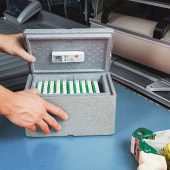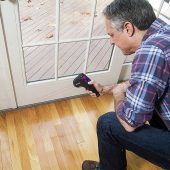Infrared thermometers operate within a certain accuracy range. A ±2°C deviation for cheaper thermometers or ±1°C for professional ones is normal.
If your infrared thermometer has a bigger deviation from this range, it’ll require calibration.
There are several ways to calibrate an infrared thermometer, ranging from simple DIY methods you can try at home to professional calibration with specialized equipment.
The best method depends on the type of infrared thermometer and the required accuracy level. Factors like traceability and certification may also determine which calibration option is ideal.
Read on to learn more on how do you calibrate an infrared thermometer.
Adjusting Emissivity
If you are getting inaccurate readings from an infrared thermometer, check if you’ve set the correct emissivity.
A surface’s emissivity determines how much infrared energy it emits, which in turn, influences the temperature reading.
Different surfaces have varying emissivity values between one and zero. Most painted surfaces and non-metals have an emissivity value is 0.95.
Cheaper infrared thermometers use this emissivity setting by default and you cannot adjust it yourself.
If you have an infrared thermometer with adjustable emissivity values, make sure you select the right value for the surface you are measuring.
Check if there’s a reference table in the manual detailing the emissivity values for different surfaces.
You can also use these emissivity references for metals and non-metals by Fluke.
Calibrating emissivity to the right value for the type of surface whose temperature you are measuring improves accuracy.
DIY Calibration
Do it yourself calibration is an option in many entry-level infrared thermometers. You first determine the measurement deviation of the infrared thermometer from the correct temperature. Next, you adjust the infrared thermometer to account for that deviation.
An easy way to check the accuracy of the infrared thermometer is by comparing its reading to that of an accurate contact thermometer.
Add crushed ice to a glass or bowl. Add ice-cold water and stir to mix it well with the ice. The goal is to create an ice bath with uniform temperature.
Dip a thermometer into the ice bath to take a temperature reading. Remove the thermometer and measure the temperature of the surface of the ice bath with the infrared thermometer.
Push the ice down gently to avoid having any floating ice on the surface of the water.
Hold the infrared thermometer at the recommended measurement distance and make sure that the lens is perpendicular to the surface of the ice water.
Check if the temperature reading on the infrared thermometer matches that of the conventional thermometer.
If it doesn’t match, calculate the deviation and then calibrate your thermometer accordingly. In most infrared thermometers, you hold a button for a couple of seconds to access the calibration settings.
Note: Make sure you’ve set the emissivity setting at 0.95 or 0.97.
Using a Calibrator
Using an ice bath is okay for basic infrared thermometers designed for home use. For a professional infrared thermometer, you need a more precise way to calibrate it.
What you need is a calibrator, of which there are two types: a black body calibrator and a flat-plate IR calibrator.
With both types of calibrators, you set the preferred temperature and then wait for the calibrator to achieve it.
Then you measure the target with your infrared thermometer. If your infrared thermometer is working right and you’ve set it to the proper emissivity setting, you should get the same temperature you set.
If the two temperatures don’t match, either adjust the thermometer’s calibration or send it to the manufacturer for calibration.
Here’s a video of a black body infrared thermometer in use.
Professional Calibration
The final option is professional calibration.
If you’ve done an accuracy test (using a calibrator or ice bath) and found the infrared thermometer to be inaccurate, you can send it to the manufacturer for professional calibration.
Some manufacturers actually recommend sending in the thermometer annually, whether it has a problem or not, for regular calibration.
Depending on your area of work, you may also be required to maintain an updated calibration certificate, meaning you have to get the thermometer professionally calibrated regularly.
If your manufacturer doesn’t offer calibration services or you don’t want to use them, there are companies and organizations that offer professional calibration along with a certificate.
Make sure you work with an organization that is UKAS-accredited.


